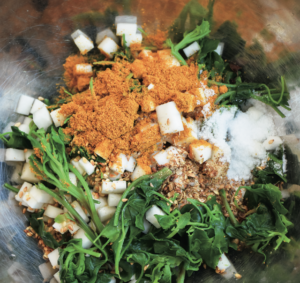Simple and Delicious: Fermented Mixed Wild Greens and Daikon Achar
According to author Pascal Baudar, “In essence, achars are a type of Indian pickles.” It is made from fruits and vegetables preserved in vinegar, brine, or specific vegetable oils. Achars tend to hold quite the punch, being both well-spiced and spicy, but can boost the flavors of whatever meal you’re eating.
This wild greens and daikon achar recipe is simple but delicious – an ideal recipe to hone your fermentation skills.
The following is an excerpt from Wildcrafted Fermentation by Pascal Baudar. It has been adapted for the web.
(Unless otherwise noted, all photography curtesy of Pascal Baudar.)
This ferment is one of my favorites and will work well with many store-bought or wild greens such as watercress, lamb’s-quarter, dandelion, chickweed, miner’s lettuce, various mustard leaves, wild radish leaves, and countless others. You can replace daikon with other large radishes (Korean radish, cherry radish, et cetera) or experiment with beets, turnips, and similar root vegetables. Carrots would probably work well, too. In early spring I incorporate tender wild turnip roots. During the winter I may add a bit of herb powder—mallow, nettles, chickweed, and so on. So really take a look at this recipe as a base to create from.
Warning! The following recipe will make you cry—probably in an awesome way, with tears of joy. But seriously, it’s quite spicy; it’s meant to be used sparingly to boost flavors. My main use is in salads; I mix in some achar with my greens to add some zing. But it’s quite good as a side condiment or topping for fish and meat, too.
 Ingredients for a 1-pint jar (475 ml) (around 70 percent full)
Ingredients for a 1-pint jar (475 ml) (around 70 percent full)
8 ounces (226 g) daikon (you can also use any other large radish roots)
5 garlic cloves, or 1 1⁄2 teaspoons (5 g) garlic powder
1 ounce (28 g) dandelion (green leaves) or other wild greens, chiffonade cut
1 teaspoon (2 g) turmeric powder
1⁄2 teaspoon (1 g) curry powder or Curry Blend
1–2 tablespoons (7.5–15 g) chile morita or other chili flakes, mild or not
1⁄2–1 teaspoon (1–2 g) ground peppercorns
1⁄2 teaspoon (1 g) ginger powder
1 teaspoon (3 g) coriander seeds
1⁄2 teaspoon (2 g) fenugreek seeds
1 teaspoon (4 g) black mustard seeds
1⁄2 teaspoon (2 g) fennel seeds
11⁄2 teaspoons (8 g) salt
2 tablespoons (30 ml) Culture Starter (this may not be necessary, but I use it anyway)
Procedure
- Trim one side of your daikon (or other radish) root and turn it to lie flat. Take your time and cut the root lengthwise into 1⁄4-inch (0.6 cm) slices, then carefully slice again into large matchsticks. Think small French fries. Cut the dandelion and place everything into a bowl.
- Mince the garlic gloves and add them to the bowl with the turmeric, curry, chili flakes, peppercorns, and ginger.
- Roasting the seeds takes a couple of minutes. I warm a cast-iron pan on high heat and place the bigger seeds in first (coriander and fenugreek). After a minute, I add the smaller seeds (mustard and fennel). Keep the seeds moving using a wooden spatula (or regular spoon). Judge doneness by smell: With high heat it should not take more than a couple of minutes. Watch out for the mustard seeds, which have a tendency to pop a bit.
- When your seeds are roasted, add them to the bowl as well. Add the salt and, using gloves, massage everything for a couple of minutes. Let it rest for 5 minutes, then massage again for another couple of minutes. You want the contents to be quite juicy. Repeat if necessary. Next, add the culture starter (active sauerkraut juice), then pack everything into a pint jar. I use the stir or shake method (fermentation method 3, page 28).
- Place the lid on top and close it, but not so tight that fermentation gases can’t escape. At least twice a day, open the jar and stir the contents with a clean spoon or fork. Most of the time I actually leave the lid closed tight to monitor the fermentation; I will burp as necessary while stirring or shaking only once a day. Both methods work well. Ferment for 7 to 10 days, and when the initial fermentation is complete (no more gases), place in the fridge. Enjoy whenever you want; the stuff will last for months. The ferment should end up quite salty on purpose.
